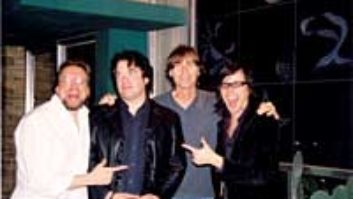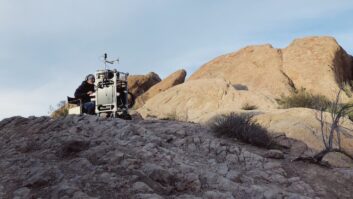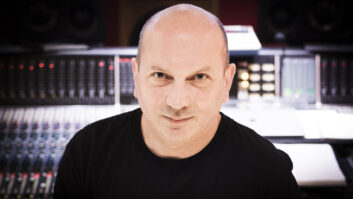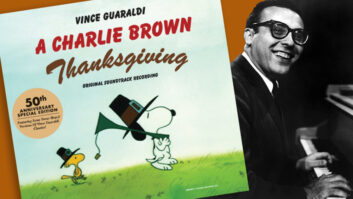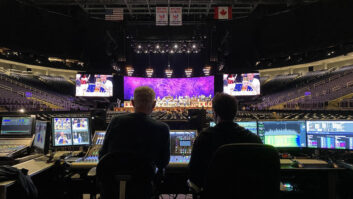MARILYN MANSON AND PRODUCER DAVE SARDY CONQUER THE GUTTERS OF “HOLY WOOD”
Marilyn Manson seems to have little trouble dancing intellectual circles around the majority of his fans and detractors. The music journalist turned self-proclaimed anti-Christ began his 1998 autobiography, The Long Hard Road Out of Hell, with an all too telling and self-prophesying passage from Nietzsche’s On the Genealogy of Morals:
In a stronger age than this decaying, self-doubting present, he must yet come to us, the redeeming man, of great love and contempt, the creative spirit, whose compelling strength will not let him rest in any aloofness or any beyond, whose isolation will be misunderstood by the people as if it were flight from reality.
Perhaps Manson’s failing is that he comes at the world from all angles: musician, visual artist, author, director, producer; he paints too many canvases with too wide of a brush, and it sometimes leaves the masses running for shelter. Then again, maybe that’s the point.
Manson’s real prominence as a celebrity figure began in ’96 with the release of the Trent Reznor-produced Antichrist Superstar — a dark, dissonant journey through societal loathing and failed rebellion that earned Manson and Co. as many fans as sworn enemies. The following album pushed the envelope in a completely different direction; ’98s Mechanical Animals saw Manson creating a parody of himself (the character Omega, a hollow, androgynous figure who is treated more like a product than a person) in an attempt to make people re-examine the notion of celebrity in modern culture. Manson also took the opportunity to jettison the Mininstry-esque industrial grind in favor of a more melodic, vocal-oriented sound — all of which played to the album’s larger themes of rebellion dissolving into merchandising.
Last fall, Manson stepped back into the public eye with the release of Holy Wood (In the Shadow of the Valley of Death). Emerging from his post-Columbine seclusion in the Hollywood Hills, Manson, as he puts it, “came out swinging.” Thematically, the new album completes the Antichrist/Animals trilogy — a trilogy that actually begins with Holy Wood, followed by Animals and ends with Antichrist. Holy Wood is centered around Adam — a thinly veiled portrait of a young Manson — an individual determined to change the world that he feels has rejected and discarded him. Sonically, the album draws on both the intensity and the melody of its two predecessors with, at times, more bombast, volume and moments of sincere vulnerability. (Numerous parallels can also be culled from the three albums, such as the reflexive significance of the 12/8 groove from “The Beautiful People” that resurfaces in both “Rock is Dead” and “Disposable Teens.”) Holy Wood comes across as a thoroughly modern hybrid of 21st century production, early electronic music and every bit of rock ’n’ roll suicide from the Rolling Stones to Sisters of Mercy.
To create his latest opus, Manson enlisted the help of Nitzer Ebb alumni/programmer Bon Harris and producer/engineer Dave Sardy, who had worked with Manson on the band’s live album, The Last Tour on Earth, as well as some soundtrack contributions. The recording process began in the fall of ’99 at Manson’s home studio in the Hollywood Hills. Manson, Harris and the rest of the band spent several months in pre-production, creating demos and experimenting with every instrument and noisemaker they could get their hands on. Harris handled all of the sequencing and tracking, which was done on Manson’s Pro Tools/Logic rig. After the band had assembled a sizable amount of material, Sardy was then asked to come aboard to engineer and co-produce the effort with Manson.
“They had about 60 songs,” Sardy explains with a laugh. “I mean, they write on the road, they write every minute of every day. They take a Pro Tools rig with them on the road and write while they’re touring. Manson had his back house set up like a project studio, and some of the vocals were done there. There was a lot of music when I got involved. They had been working with a programmer, Bon Harris. They had been kind of doing demos with him and working on stuff and just going crazy in his pool house for a bunch of months. And then I got involved and just kind of helped go through the process of which songs they wanted to record and which ones to push further.”
Sardy and Manson were impressed with how tight the band had become in the past couple of years and wanted to incorporate a more performance-driven approach in the recording of Holy Wood. “Having done the live record together,” Sardy continues, “we were blown away by how good the band sounded live. We had been A/B’ing between the live versions and the album versions, and the excitement of the live versions was just outrageous. We definitely tried to push more of a performance approach, as opposed to all electronic. And it’s just the natural evolution for any touring band; you go out on the road for a bunch of years, and you’re just going to get really good. There’s no way around it. That was a goal of both Manson and me; we wanted to make a very electronic-sounding record but a very organic record — take organic sounds and process them and use performances, as opposed to all sequencing and MIDI.”
Following the initial round of pre-production, the band then moved from Manson’s home studio to the one-time home of Harry Houdini in Laurel Canyon. Upon moving into the turn-of-the-century mansion, the band converted the 2,000-square-foot-plus ballroom into the main Pro Tools-equipped tracking room, which included a Neve 8038 and a Studer 800. Additionally, there were several smaller Pro Tools rooms, each with a dedicated focus: keyboards, drums, acoustic instruments, etc.
An “anything goes” work ethic and an insatiable desire to experiment permeated the entire recording process. The band incorporated everything from classic synths and guitar amps to the latest plug-ins and outboard gear. “Well, we actually wound up with a lot of older synthesizers and organs and old Moogs and Rolands,” recalls Sardy, “and the Nord Lead, which is phenomenal; it’s like having a huge patchable synth right at your fingertips. Then with Pro Tools you can do a lot of processing to acoustic sounds through the various plug-ins and the automation, which is phenomenal. We combined a lot of live drums with old drum machines and toy drum machines. We were experimenting in the way we actually recorded stuff. There was a lot of recording things using the themes of the songs, the thematic approach of the song and where the song placed in the album. We recorded outside in the rain, in the desert. It was like a year of experimenting.”
The PCP Splitter by Little Labs was also used extensively in tracking guitars and bass; the splitter allows one guitar lead to be split among several different amp heads or effects units without any signal loss. “We had about 15 or 20 different vintage heads in the room and more guitar pedals than any human has the right to look at in their life,” Sardy explains with a chuckle. “It was fun; we would just sit there and recombine things through bass amps and things like that. It was a lot of working with old vintage amps and weird Italian amps. On this record, though, I’d say the difference is that we used a lot of combinations of processed guitar, like a guitar plug-in, and maybe a big, fat, old-sounding amp. It’s the way you’d imagine a ’70s record sounding. That was at least [bassist] Twiggy’s comment after listening to the album.”
For vocals, Sardy again indulged in everything from the conventional to the bizarre. Some of his favorite mics for vocals included an UM-251, SM7, U67, some older Unit 9 mics and even a re-wired CB radio. The album’s vocals were also cut in numerous locations, ranging from closets to empty swimming pools. “Every aspect of the record was like we had a pile of crazy old junk and a pile of ultramodern equipment and combining the two — definitely the way to go.
“It’s a pretty deep record,” Sardy concludes. “There are a lot of heavy, slower songs and serious, aggressive songs. It’s a pretty emotional record, in that you’re running the gamut between all of the emotions, which is great.”
THUS SPOKE THE ALCHEMIST
Just prior to embarking on the current “Guns, God and Government” world tour, Marilyn Manson took some time to chat with Mix about the writing and recording process that produced Holy Wood.
Take us through the last year or so. You guys came off of the Mechanical Animals tour a little prematurely following the whole Columbine mess; what was your next move?
Things kind of got pulled out from under us. At the end of that tour, a lot of things were cancelled, a lot of doors were shut on us by a lot of people. We were put in a position where there was almost a need to respond. But rather than do it in the press or do it how the media would like us to do it — in a way that would just help them exploit the whole situation further — I locked myself away in a room for probably about three months, literally. And I came out with the ideas and the lyrics and the story of Holy Wood, completing the trilogy I started with Antichrist Superstar. This became the glue that bound them together.
At that point, which was before the end of [’99], I set up a studio in my pool house. An interesting thing about where I moved in is that the Rolling Stones had lived here and wrote Let it Bleed in this house. And if you ever watch that bootleg movie Cocksucker Blues, there are some scenes with them in my living room, composing some of the songs. My house has a very good inspirational atmosphere, as far as the writing went. So we did all of the songwriting here in my home studio, which took us up until about the beginning of the year. The band was very prolific — we probably wrote about 100 or so different things, 30 of which were turned into legitimate songs, 19 of which actually ended up on the album.
Is this the point when you guys were working with Bon Harris?
Yeah. At this point you could call it pre-production or demoing. But, in reality, a lot of the tracks we laid down while writing ended up on the record, sometimes vocal tracks, sometimes guitar stuff, almost all of the keyboards. And that was working with Bon Harris doing editing in Logic and sequencing and working with my keyboard player [Pogo] and my drummer [Ginger Fish]. At that point, we decided to bring in Dave [Sardy] to co-produce and to engineer, because we wanted to take what we had kind of up to another level and record live drums and maybe try and track better guitars and bass and vocals, and just experiment and see if we could beat what we had. That’s when we moved into the Harry Houdini house.
Was there ever a thought to bring Michael Beinhorn back in to produce another album?
No. When I go back and I listen to demos for Mechanical Animals, they’re so similar to the final product that I felt like, while he was good to work with, I didn’t get anything new from him. And I didn’t think that he really took it to another level as I had expected or maybe it was already at that level. I thought sometimes he ended up polishing things a little too much to the point that it took off some of the magic or the edge.
It was certainly a sparser album than Holy Wood.
Yeah. What Dave did was great as both a co-producer and as an engineer. He got me to try different things that I normally wouldn’t do. The record is probably unlike things he’s done before, because it’s very electronic, but it sounds more organic than you’d expect. We kind of wanted to create a combination between The Beatles and Einstürzende Neubauten, something that was hard and ugly but also put together in a beautiful, melodic way. And I feel like we got to that point.
Was that something you were trying to tie into the thematic substance of the album?
Well, I think because I wanted this to tie all three records together, I suppose, just unconsciously, the songwriting is a pretty good combination of Mechanical Animals and Antichrist Superstar. What Antichrist Superstar lacked in melody, it made up for in just brutality. Mechanical Animals was very melodic. It wasn’t about rage on that album; it was more about dynamics and subtlety. It was a different type of record. This one was a good combination of the two I think.
What’s the songwriting process like between you and the rest of the band?
On this album, I think it’s almost split down the middle. Either Twiggy and I went off to write them together, and our writing process would get as extreme sometimes as taking a trip out to Death Valley with an acoustic guitar and mini cassette recorder, or writing until the sun comes up and drinking absinthe to the point that we don’t remember what we did until the next day, and we’re surprised that we did something great — just letting the subconscious take over. And then working with John is very different. He, musically, is more learned and probably the most talented musician in the band, but he will probably not ever have the feel that someone like Twiggy has. And while Twiggy is a great musician, his strength is his ability to make music around what I’m thinking. Whereas John just has a great ability to make music, and sometimes I would write lyrics or try and shape things around his music, or I’d have to change some things that he would do to make them fit. We would put all of this together as a band and come up with new ideas and shift things around. I think with this record…this is the first time that Marilyn Manson sounds and feels like a real band.
Given the current music climate with people like Eminem and Slipknot, do you think the bar has been raised for what’s considered shocking?
No. I think there’s nothing new under the sun. I think anything that I could say or do, someone else has already done in different ways hundreds of years ago. And if not music, then in some other form. I think the standard has been raised for making better records, because you just don’t have the opportunities that you did 10 years ago. Fortunately, I’ve managed to establish a very loyal fan base that continues to grow. But there are not a lot of career artists left anymore. I can see a lot of bands disappearing. Someone who is huge now may not even be around in another two or three years. When I made this record, I really set out to make the record I wanted, and almost bitterly, I couldn’t care less about commercial success. But, I didn’t let that get to the point of self-indulgence, which some people can. That’s the good thing about having someone come in to work with you. They can be a sounding board and tell you if something is working or encourage you to make something better, or whatever the case may be.
